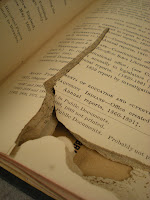
We got mentioned in Duke Today's story about the Tin Foil Men popping up on campus. Yes, we are slightly obsessed about these. We love whimsy, and chocolate. But that's a completely different post.
Dispatches from the Duke University Libraries Preservation Department
Our blog has moved!
You should be automatically redirected in 6 seconds.
If not, visit
http://blogs.library.duke.edu/preservation/
and update your bookmarks.

 We got a visit from our favorite local artist today. Hoorah! If you are in Perkins, swing by and say hello. Just dont' ask him where to find a book.
We got a visit from our favorite local artist today. Hoorah! If you are in Perkins, swing by and say hello. Just dont' ask him where to find a book.
 Alex Marsh is a Digitization Specialist in the Digital Production Center. He has been with us for five months and works primarily with rare and fragile materials from a variety of collections. He has recently worked with the Ethiopic Manuscripts collection, Duke University Herbarium materials, and American broadsides from the Rare Book, Manuscript, and Special Collections. Many of these will be made available through our digital collections portal.
Alex Marsh is a Digitization Specialist in the Digital Production Center. He has been with us for five months and works primarily with rare and fragile materials from a variety of collections. He has recently worked with the Ethiopic Manuscripts collection, Duke University Herbarium materials, and American broadsides from the Rare Book, Manuscript, and Special Collections. Many of these will be made available through our digital collections portal. When asked to describe one of his favorite projects he said:
When asked to describe one of his favorite projects he said:"The most interesting collection I have worked with so far are the Ethiopic manuscripts. They are very old and fragile and I cannot read the text, so I feel like an archeologist when I am handling them. Photographing the pages is tricky because they often do not lay flat, which causes focus issues, and, because I cannot read the text, it is possible to inadvertently miss a page or photograph the same page twice if I am not careful. It is exciting to work with such rare material and I look forward to seeing the project in digital format after completion."

 Sure, you can tape book pages together or attempt DIY book repair, but if your collection is valuable to you sentimentally or monetarily, it is best to consult a professional conservator. A good conservator will give you a range of options from an enclosure to full treatment and should be able to discuss with you, in plain English, what your choices are and how they will affect your material. Do not be afraid to ask questions. We conservators love to talk business. We also love to talk food...but that is a completely different blog post.
Sure, you can tape book pages together or attempt DIY book repair, but if your collection is valuable to you sentimentally or monetarily, it is best to consult a professional conservator. A good conservator will give you a range of options from an enclosure to full treatment and should be able to discuss with you, in plain English, what your choices are and how they will affect your material. Do not be afraid to ask questions. We conservators love to talk business. We also love to talk food...but that is a completely different blog post. Digital objects
Digital objects






